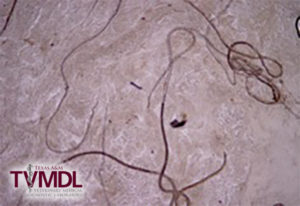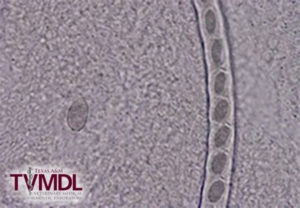Threadworms found in Chukar partridges
By Martin Ficken, DVM, PhD, Gonzales Resident Director
With over 800,000 tests run annually, TVMDL encounters many challenging cases. Our case study series will highlight these interesting cases to increase awareness among veterinary and diagnostic communities.
A flock of approximately 3000 Chukar partridges, aged five months and older, were experiencing a decrease in performance and a slight increase in mortality. The birds continued to eat but many lost weight and eventually died. No overt respiratory or digestive clinical signs were observed. Six live, 5-month-old Chukar partridges were presented to the Texas A&M Veterinary Medical Diagnostic Laboratory (TVMDL) in Gonzales for necropsy. At the time of examination, all birds were alert, but most were very thin with prominent keels.
All birds were similar in necropsy findings with mild to severe breast muscle atrophy. Feed was present in both the crop and gizzard. The small intestines were slightly reddened and the mucosa of the duodenum and jejunum in some birds was mildly thickened while in others the intestinal tract appeared within normal limits.
Intestinal scrapings of the duodenum and jejunum demonstrated large numbers of long, thin, thread-like worms consistent with Capillaria obsignata (Figure 1). Many of these worms contain numerous double operculated eggs (Figure 2).
No other significant lesions were observed in any other tissues or organ systems. Capillaria obsignata is a nematode parasite of domestic poultry, game birds, and wild birds. It has a direct life cycle and does not require an intermediate host. It is found in the small intestinal mucosa where it can cause a catarrhal exudate and thickening of the mucosal wall. Morbidity and mortality are possible in heavy infestations.
To learn more about this case, contact Dr. Martin Ficken, Resident Director at the Gonzales laboratory. For more information about TVMDL’s test offerings, visit tvmdl.tamu.edu or call 1.888.646.5623.
Reference:
McDougald, LR. Internal parasites in Diseases of Poultry 13thedition Wiley-Blackwell, ed. Swayne, DE et al. p. 1121, 2013.

